
How To Improve Your Riding On A Snowboard
This tutorial covers a few issues that many intermediate snowboarders experience while riding. We'll teach you how to spot them and give you the skills to improve upon them. This tutorial is mostly related to body position, because if you are able to get your body position correct, you'll ride a hell of a lot better!
To get the Goofy version of this tutorial, check out the Snowboard Tutorial Membership, if you swing that way...
(Riding/Narrating: Nev Lapwood)
Film Your Riding
Nearly all snowboarders encounter the same problems with their technique. The problem is, most people do not know they have any of these issues going on until they have seen it for themselves. The solution, get out there with a buddy and film it!
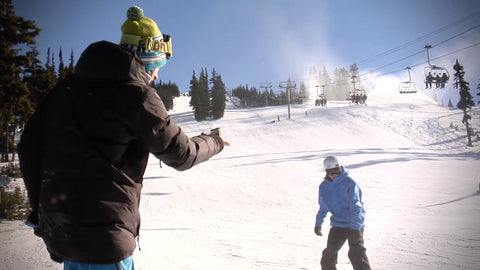 Film with a buddy, just don't end up on Jerry Of The Day!
Film with a buddy, just don't end up on Jerry Of The Day!
You don't need anything fancy here; a video camera, GoPro or even the video camera on your phone will work. This is going to work wonders for your riding because you'll be able to pick up small riding characteristics or areas of improvement that you may not have noticed yet.
Ideal Turns
Ideal intermediate turns on a snowboard look like this:
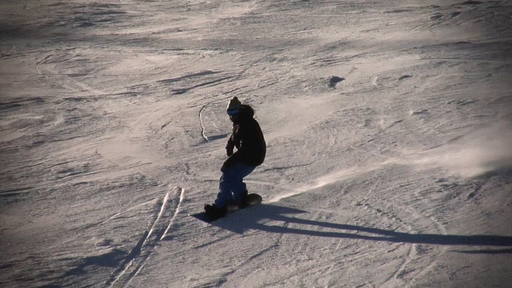 The perfect turns, at different speeds for your viewing pleasure.
The perfect turns, at different speeds for your viewing pleasure.
Here, you can see that each turn has a smooth, consistent radius while the speed is controlled throughout each turn. The way to do this is to have your knees bent, your hips pushed forward and a straight upright back. Your whole body should be making each turn in unison, meaning that your upper and lower body need to be aligned and move together.
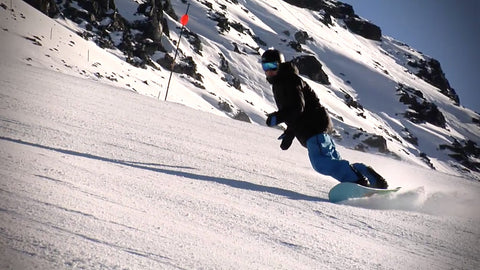 This is the nobody turn. Because nobody's perfect.
This is the nobody turn. Because nobody's perfect.
Straight Legs
The first problem that many people have, is trying to ride with straight legs. While snowboarding, you need to bend your knees, which will allow you to cruise through all those little bumps and inconsistencies in the snow.
 Straight legs = straight style killer.
Straight legs = straight style killer.
Riding with straight legs creates a whole bunch of problems:
- Awkward looking toeside and heelside turns
- Bending over which puts you in a highly unstable riding position
- Weight over the heel edge of the board which leads to chatter through turns
- 110000% more likely to fall. You need to bend your knees to absorb the changing terrain.
What you want to do is be in a position where the front of your shins are being pressed into the tongue of your boot. This allows you to bend your knees, push your hips forward and keep your back straight.
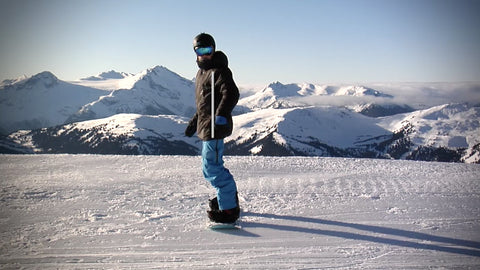 Straight Back and ready to rip!
Straight Back and ready to rip!
Counter Rotation
For smooth controlled riding, you want your upper and lower body to be in line with each other. This will give you better balance and stability in your riding. One of the most common problems for intermediate riders is that they ride with a body position which is out of line, a counter rotated position (like the rider below):
 This is a counter rotated position. This is bad during normal turns but good when trying to stop!
This is a counter rotated position. This is bad during normal turns but good when trying to stop!
Know the difference!
You will see a lot of people going down the mountain with a body position which looks like the above. This position creates awkward, unstable turns. What you want to do is keep your shoulders, hips and knees all aligned with your board, so that your upper and lower body are always heading in the same direction.
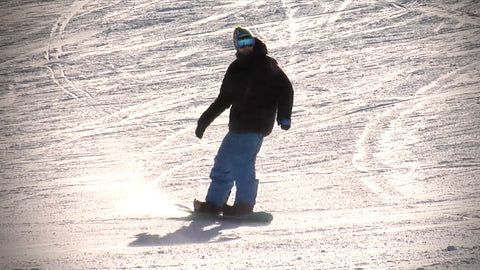 It looks smooth, balanced and effortless because it is.
It looks smooth, balanced and effortless because it is.
You probably don't know if you counter rotate or not until you see yourself ride, which is why it's so important that you get footage of yourself.
Uncentered Hips
Many riders get into the habit of sliding their back foot around on each turn, going from sideslip to sideslip. This is usually the result of having your hips slightly too far forward, causing too much weight to be put over your front foot. If your hips aren't centred, your body position isn't as stable as it could be.
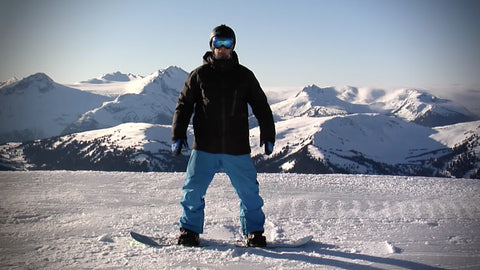 Keep your hips centered and you'll be in a balanced position.
Keep your hips centered and you'll be in a balanced position.
On a mellow slope, try hopping along as you do a toeside traverse. Then as you make the transition onto your heel edge, try hopping on your heels. This tactic helps bring your weight back to be more central over your feet but will also make your turns rounder and larger.
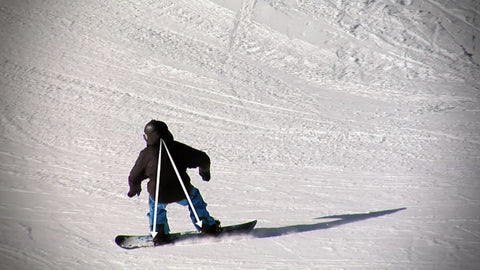 Once you've got that dialled, stop the hopping throughout the turn but keep the nice wide turns.
Once you've got that dialled, stop the hopping throughout the turn but keep the nice wide turns.
That's how you improve your riding! Remember, get out there with a buddy and film your snowboarding, so you can see exactly what you look like when riding. Then, use these tips to help improve your riding skills all over the mountain.
Want Even More Training Tips?
Alex McCann
Snowboard Addiction
Our Goal Is To Improve Your Riding

 Film with a buddy, just don't end up on Jerry Of The Day!
Film with a buddy, just don't end up on Jerry Of The Day! The perfect turns, at different speeds for your viewing pleasure.
The perfect turns, at different speeds for your viewing pleasure. This is the nobody turn. Because nobody's perfect.
This is the nobody turn. Because nobody's perfect. Straight legs = straight style killer.
Straight legs = straight style killer. Straight Back and ready to rip!
Straight Back and ready to rip! This is a counter rotated position. This is bad during normal turns but good when trying to stop!
This is a counter rotated position. This is bad during normal turns but good when trying to stop!  It looks smooth, balanced and effortless because it is.
It looks smooth, balanced and effortless because it is. Keep your hips centered and you'll be in a balanced position.
Keep your hips centered and you'll be in a balanced position. Once you've got that dialled, stop the hopping throughout the turn but keep the nice wide turns.
Once you've got that dialled, stop the hopping throughout the turn but keep the nice wide turns.